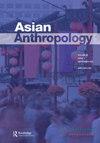博物馆就像一座寺庙:台湾佛光山佛祖博物馆1
Q2 Social Sciences
引用次数: 1
摘要
摘要本文描述了台湾最大的佛教团体之一佛光山(FGS)建造的博物馆是如何激发游客的情感和精神的。我们探讨FGS创始人星云对物质性的概念是如何在FGS佛像博物馆(FGS-BM)向游客展示的,以及人文佛教是如何在博物馆中物质表达的。通过分析博物馆空间,并通过人种学研究调查游客对FGS-BM的反应,我们描述了FGS如何利用实物、博物馆空间和具体活动向俗人传达佛教意识形态,引发了一些游客的情绪,并导致一些人将博物馆描述为类似于寺庙。本文章由计算机程序翻译,如有差异,请以英文原文为准。
The museum is like a temple: the Fo Guang Shan Buddha Museum in Taiwan1
Abstract This article describes how a museum built by the Taiwanese Fo Guang Shan (FGS), one of the largest Buddhist groups on the island, triggers emotions and spirituality in its visitors. We explore how the conceptualization of materiality by the founder of FGS, Hsing Yun, is presented to visitors at the FGS Buddha Museum (FGS-BM) and how Humanistic Buddhism is materially expressed at the museum. By analysing the museum space and investigating visitors’ responses to the FGS-BM through ethnographic research, we describe how the FGS uses material artefacts, museum space and embodied activities to communicate Buddhist ideology to the laity, triggering some visitors’ emotions and leading some to describe the museum as being similar to a temple.
求助全文
通过发布文献求助,成功后即可免费获取论文全文。
去求助
来源期刊

Asian anthropology
Social Sciences-Anthropology
CiteScore
1.60
自引率
0.00%
发文量
25
期刊介绍:
Asian Anthropology seeks to bring interesting and exciting new anthropological research on Asia to a global audience. Until recently, anthropologists writing on a range of Asian topics in English but seeking a global audience have had to depend largely on Western-based journals to publish their works. Given the increasing number of indigenous anthropologists and anthropologists based in Asia, as well as the increasing interest in Asia among anthropologists everywhere, it is important to have an anthropology journal that is refereed on a global basis but that is editorially Asian-based. Asian Anthropology is editorially based in Hong Kong, Taiwan, and Japan, but welcomes contributions from anthropologists and anthropology-related scholars throughout the world with an interest in Asia, especially East Asia as well as Southeast and South Asia. While the language of the journal is English, we also seek original works translated into English, which will facilitate greater participation and scholarly exchange. The journal will provide a forum for anthropologists working on Asia, in the broadest sense of the term "Asia". We seek your general support through submissions, subscriptions, and comments.
 求助内容:
求助内容: 应助结果提醒方式:
应助结果提醒方式:


